Cellular Factories
Cellular Factories
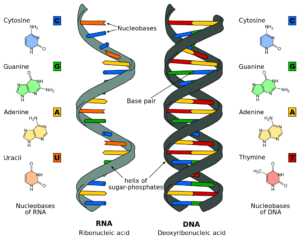
RNA and DNA Comparison: By File:Difference DNA RNA-DE.svg: Sponk / *translation: Sponk – Chemical structures of nucleobases by Roland1952, CC BY-SA 3.0, Link
Cellular factories are present in every living cell, making the vast amounts of organic molecules required for life. The cell can be likened to a factory where components required for cellular functions are continually made on-demand, and waste products are simultaneously packaged for disposal. It is a very tightly controlled factory with very little wasted activity.
Enzymes control much of this functionality, with multiple feedback loops controlling whether a particular cellular product is needed.
It is very complicated. It is rather like a fractal painting – the closer you look, the more detail you see – the most complicated everything becomes. As science has advanced over the 170 years since Darwin, we have uncovered the fantastic complexity of even the most simplest bacteria.
This complexity has made is impossible so far for anybody to create a simple bacteria from shelf chemicals. Yet, somehow, we are asked to believe such a creation could occur in nature under uncontrolled conditions.
This complexity of life is often not appreciated by the general public – and even by some biologists. In 1871, Darwoin wrote in a letter to Joseph Hooker,
Nowadays large organic molecules would not last long enough to be noticed; they would be quickly absorbed and broken down by bacteria or other living creatures.
Similarly, Darwin noted in his book The Selfish Gene,
But bacteria and the rest of us are late-comers, and in those days (on the early Earth) large organic molecules could drift unmolested through the thickening broth.
Darwin then posits,
At some point, a particularly remarkable molecule was formed by accident. We will call it the Replicator. It may not necessarily have been the biggest or the most complex molecule around, but it had the extraordinary property of being able to create copies of itself.
The hypothetical self-replicating molecule is needed by origin-of-life accounts. A functional protein would be of little importance if there were not some mechanism for this protein to be preserved and somehow duplicated over time. Once this self-replicating molecule was formed, then Darwinian evolution could kick in and before you knew it – man would walk on the Earth.
At least that is how the story goes.
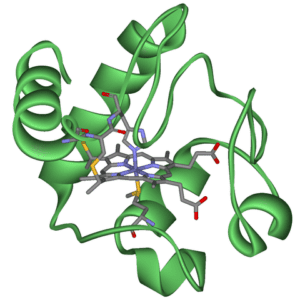
A life protein – By Klaus Hoffmeier – <span class=”int-own-work” lang=”en”>Own work</span>, Public Domain, Link
But the problem is in the details. First, while it is easy to imagine a “remarkable molecule” in the brain of Richard Dawkins, it is very difficult to make. Additionally, it is difficult to know how it would accomplish the task of self-replication in a hostile environment being watered down by other competing molecules. There has been a considerable amount of work done in the molecular biology laboratories of the world trying to manufacture such a molecule – but nobody has quite been able to create this Dawkins “remarkable molecule.”
Papers have been published with nightly news announcers breathlessly professing some great breakthrough in our understanding as to how life began on Earth – but these claims always turn out to be extremely misleading.
The reason why such a molecule has not been found is not for lack of effort but for a more fundamental reason.
Advancing molecular biology has demonstrated that life could not arise by chance through a single event – or even through a series of events. But maybe if the process could be broken down into a series of events some likely scenario could be discovered. Many origin-of-life scientists believe the first step in this process has to be with some form of self-replicating molecules; once this is found, the forces of natural selection and time will provide the means to gradually evolve mankind.
For example, an article discussing origin-of-life research by David Horning and Gerald Joyce notes,
Research into the origin of life takes for granted that the first living thing was much simpler than any existing life. … A some point, one molecule acquired the ability to replicate itself from chemicals found on the primordial Earth. Once that took place, Darwinian evolution could take over.
Characteristics of the First Cellular Factory
There are four requirements for the first chemical factory,
- It has to be able to form under natural conditions (not from chemicals supplies by a scientist),
- I must make copies of itself by locating small molecules that would be available in its environment,
- The molecule has to be stable enough so that it could exist in the real world – an Earth “primordial soup”
- It has to be able to mutate and change in order to allow natural selection to occur
Consideration of these challenges shows the complexity of producing the initial replicating organism. In short, we have no idea how to do this – even in the controlled environment of a modern molecular biology laboratory.
Extensive research at origin-of-life laboratories over the past several decades provide reasons to conclude that a single molecule could not have performed all of these activities. Computer viruses can replicate themselves but they are instructed to do so through an intelligent designer. Computers programs do not design themselves.
A single molecule would have great difficulty pulling all of this off. It would initially lack a cell membrane to segregate itself from other chemicals resulting in unwanted chemical reactions. It would then need to somehow acquire the building materials required to reproduce itself in a likely hostile environment. This molecule would end up being much more complicated than most organic molecules as it would have to perform many independent functions.
The question is not whether an intelligent designer might someday be able to generate such a molecule. The question is whether mindless natural forces could produce it. Neither DNE or RNA come even close to having the capabilities needed to reproduce itself all by itself.
Cellular Structure
Each one of the trillions of cells within the human body is a work of nanotechnology far beyond anything capable of being replicated today. Michael Denton imagines magnifying a cell in order to better observe and understand its working parts.
What we would be witnessing would be an object resembling an immense automated factory, a factory larger than a city, and carrying out almost as many unique functions as all the manufacturing activities of man on earth. However, it would be a factory that would have one capacity not equaled in any of our own most advanced machines, for it would be capable of replicating its entire structure within a matter of a few hours. To witness such an act … would be an awe-inspiring spectacle.
The origin-of-life scientists today are focused on trying to find or build one of these self-replicating molecules. The assistance on the materialistic origin of life without any intervention from an intelligent creator makes the materialist propose a conclusion that is simply not supported by the facts. In fact, the suggestion this complexity could arise by chance argues against what we knew by engineering.
Summary
The origin of a self-replicating factory from nothing is what is required by origin-of-life scientists. As scientist Eric Anderson notes,
The abiogenesis paradigm, with its placement of self-replication as the first stage of development, is fundamentally flawed at a conceptual level. It is opposed to both the evidence and our real-world experience and needs to be discarded.

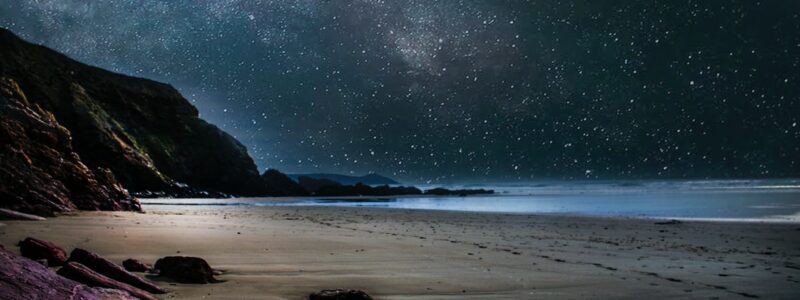
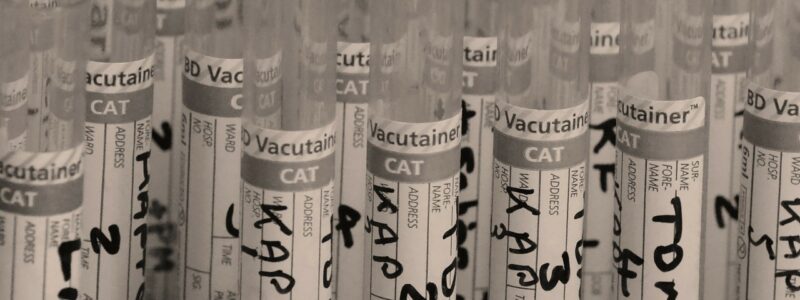

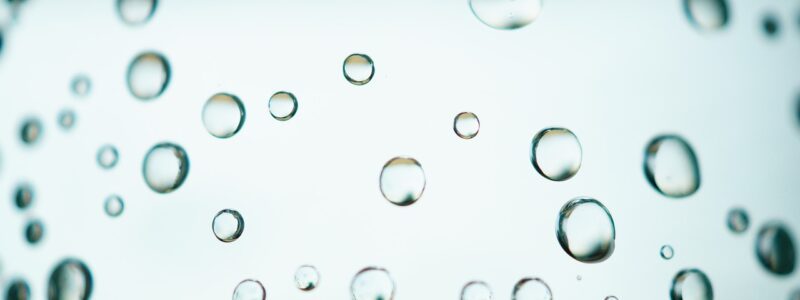
This is amazing and so interesting to read about cells, cellular factories, RNA and DNA. I’m amazed how our “intelligent creator” as you refer has created us and that scientists have spent hundreds of years trying to analyse it.
I have a question – I keep reading and hearing about the COVID vaccines having messenger RNA (mRNA) technology that can alter our DNA permanently. Given you have some knowledge of this topic, I’d live to hear your thoughts on if this is true and also the risks and considerations we should follow before taking the vaccines. Feel free to link to any articles – I’ll be waiting. Thanks in advance John
Thank you for your kind remarks concerning this post.
I will be glad to help you with the new COVID vaccinations. These are revolutionary – they hold tremendous promise not just for being a new form of vaccine that has a great possibility of preventing viral illnesses. It also if a fundamentally new way to fight cancer. Cancer cells also express foreign proteins that can be targeted by these new vaccines.
Now as to your question. There is no way on God’s green earth that the mRNA COVID vaccine can affect somebody’s DNA. None, Zip, Nada.
How this vaccine works is remarkable. The messenger RNA codes for a protein on the virus that the virus uses to attach itself to cells within the body – particularly to lung cells. The mRNA in the cytoplasm attaches to a complex system of proteins in the cytoplasm called ribosomes that make a protein from the information contained within the messenger RNA. The protein then leaves the cell and attaches to a viral protein inactivating the virus.
Messenger RNA (mRNA) can not get into the nucleus, it can not get into the DNA (mRNA is RNA and not DNA) and it can not change somebody’s DNA.
Here is a scientist from CHOP – Children’s Hospital of Philadelphia – to further explain this process.
Explanation
I hope this will satisfy your concerns because the mRNA vaccine simply can not affect your DNA. What it can do is to save your life if you get COVID. I am a critical care / lung doctor and help care of dying patients on ventilators with their lungs destroyed by the virus.
Dave.
Hi David! I went through your article and, believe me, I’m truly amazed. My niece spoke about cellular factories with me last week and I denied that there’s such thing called cellular factory. After reading this post I now know that he was right.
So, this means that we need cellular factories in our body cells so that the organic molecules required for life can be developed? Science can be very complicated and hard to understand indeed.
Anyway, thanks for sharing this helpful piece of writing with us. I will be sharing it with my niece, I think he’ll need it for his studies too.
Thank you for your kind comments! I am pleased you liked the site! Yes, every cell in our body is an organic c chemistry lab making organic molecules many of which we can hardly make in our most modern labs.
Dave.